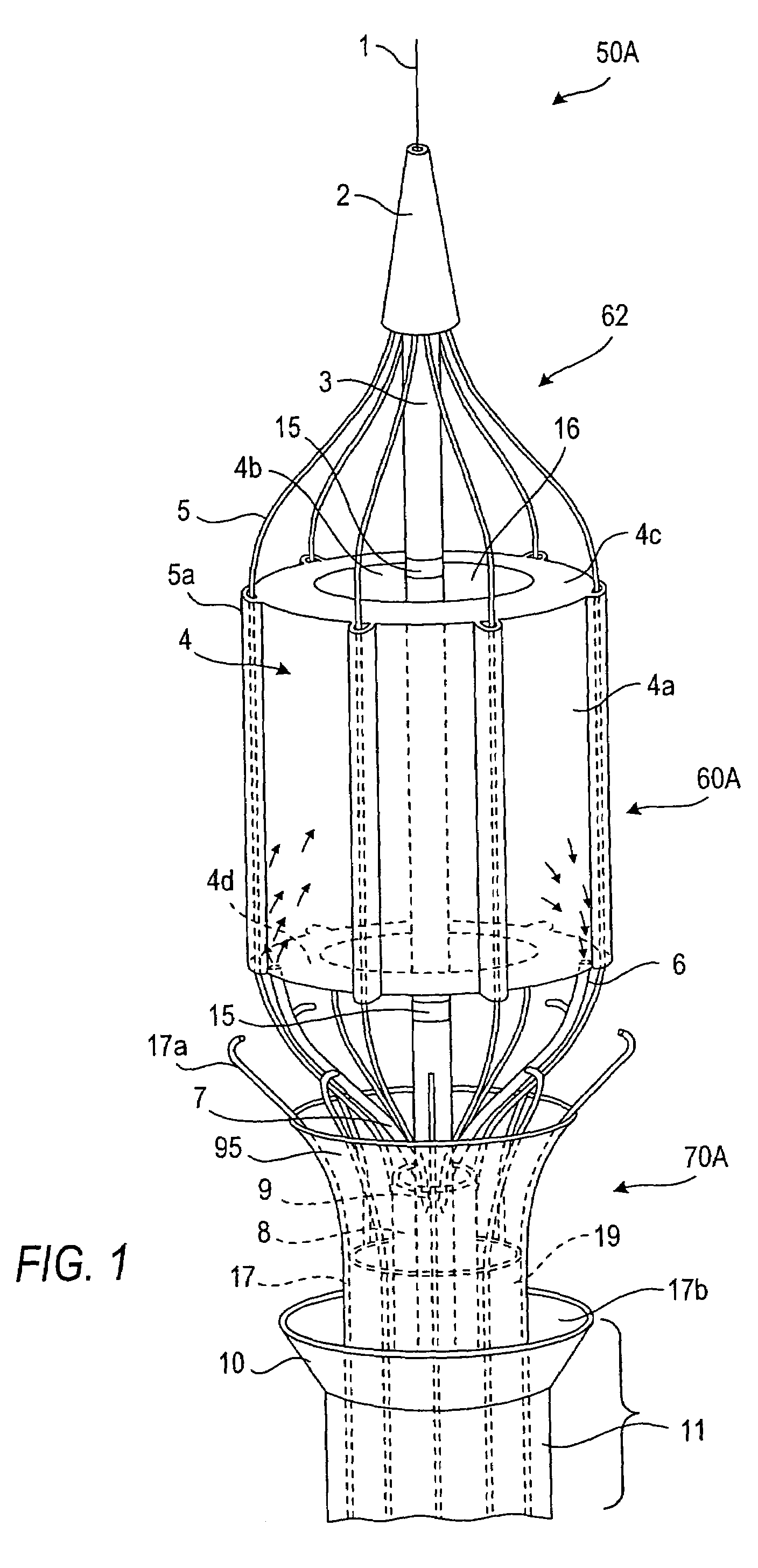Apparatus for delivering, repositioning and/or retrieving self-expanding stents
a technology for self-expanding stents and apparatuses, which is applied in the field of apparatus for delivering, repositioning and/or retrieving self-expanding stents, can solve the problems of stents being buried completely in the vessel wall, bes being less flexible than self-expanding stents, and less capable of being delivered through tortuous vessels. achieve the effect of enabling the precise positioning of the sten
- Summary
- Abstract
- Description
- Claims
- Application Information
AI Technical Summary
Benefits of technology
Problems solved by technology
Method used
Image
Examples
first embodiment
[0107]Referring now to the drawings in which like reference characters designate identical or corresponding parts throughout the several views, and more particularly to FIGS. 1-3, apparatus in accordance with the invention comprises a catheter assembly 50A (only the distal end region of which is shown), a thermal transfer device 60A connected to catheter assembly 50A and an associated stent capturing device 70A. Catheter assembly 50A comprises a low profile outer core catheter 8, having an inner movable core catheter 3, an inner stent-capturing sheath 19 situated over the outer core catheter 8, and an outer stent-receiving sheath 11. In this embodiment, the thermal transfer device 60A comprises a frame assembly 62 to which an expandable balloon 4 is connected. Balloon 4 has a sleeve-type configuration, i.e., the balloon 4 has an annular cross-section along its entire length. As discussed below, this shape is advantageous since the flow of blood or other body fluid which normally occ...
second embodiment
[0120]A modification of the second version of the second embodiment is shown in FIG. 8a, where the frame wires 5 are paired and interconnected with a single bridging bar 98 in their central portions. The stent-capturing sheath 19 with the capturing hooks are eliminated in this modification. Instead, there are at least four capturing wires 96, which are molded to the inner core catheter 3 at the base of conus 2. The capturing wires 96 extend parallel to the frame wires 5, but outside the balloon 12 and pass under the bridging bars 98 between the central portions of the paired frame wires 5. The relative motion of the movable core 3 and the outer core catheter 8 promotes opening and closing of the capturing wires 96. When the balloon 12 is expanded, capturing wires 96 open with it. When the balloon is slowly deflated, the capturing wires 96 stay open and do not follow the collapsing balloon until the angled portion of the capturing wires become engaged with the bridging bars 98, which...
third embodiment
[0133]Referring to FIGS. 13-16, a first version of apparatus in accordance with the invention comprises a thermal transfer device 60C associated with a catheter assembly 50C and including a stent capturing device 70C. The thermal transfer device 60C comprises an inflatable and collapsible balloon 20 formed of the same type of material as that from which balloons 4 and 12 are made. The balloon 20 has a cloverleaf configuration in the cross sectional view (FIG. 14a). Balloon sectors 201-204 merge with each other at the proximal and distal ends of the balloon (FIG. 14 and FIG. 15) and in the center of the balloon define radial spaces 201-4, 201-2, 202-3 and 203-4 between them (FIG. 14a). Each of the radial spaces are formed by a pair of opposed radially and axially extending wall members 94 extending between the outer wall of balloon 20 and the inner core catheter 3. The distal end of the balloon is attached to the inner core catheter 3 at the attachment of the cone 2 and the proximal ...
PUM
 Login to View More
Login to View More Abstract
Description
Claims
Application Information
 Login to View More
Login to View More - R&D
- Intellectual Property
- Life Sciences
- Materials
- Tech Scout
- Unparalleled Data Quality
- Higher Quality Content
- 60% Fewer Hallucinations
Browse by: Latest US Patents, China's latest patents, Technical Efficacy Thesaurus, Application Domain, Technology Topic, Popular Technical Reports.
© 2025 PatSnap. All rights reserved.Legal|Privacy policy|Modern Slavery Act Transparency Statement|Sitemap|About US| Contact US: help@patsnap.com



